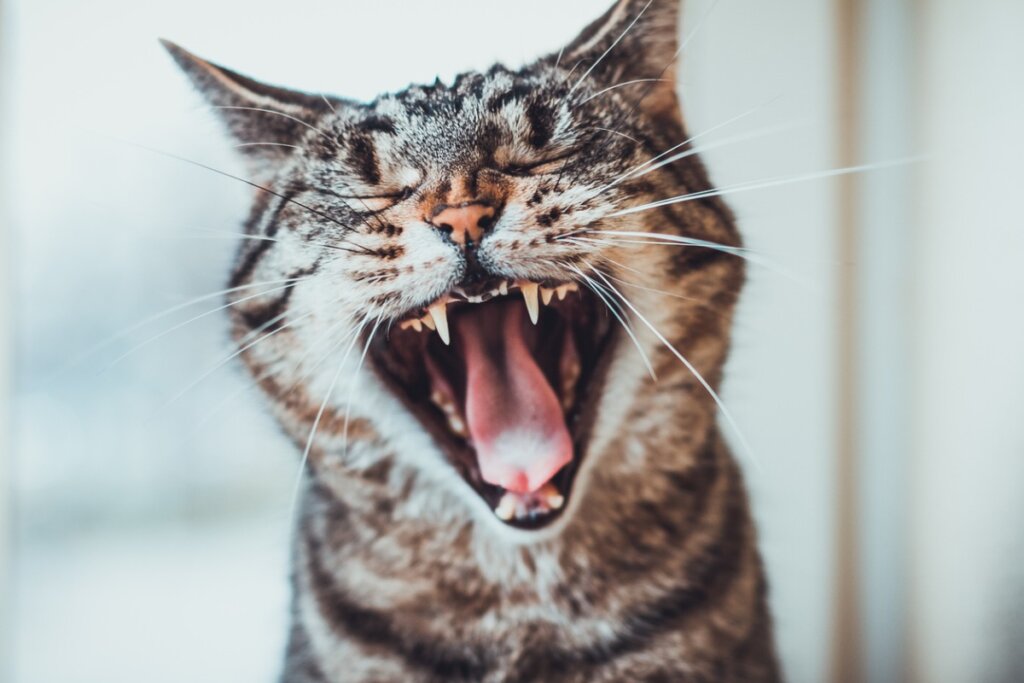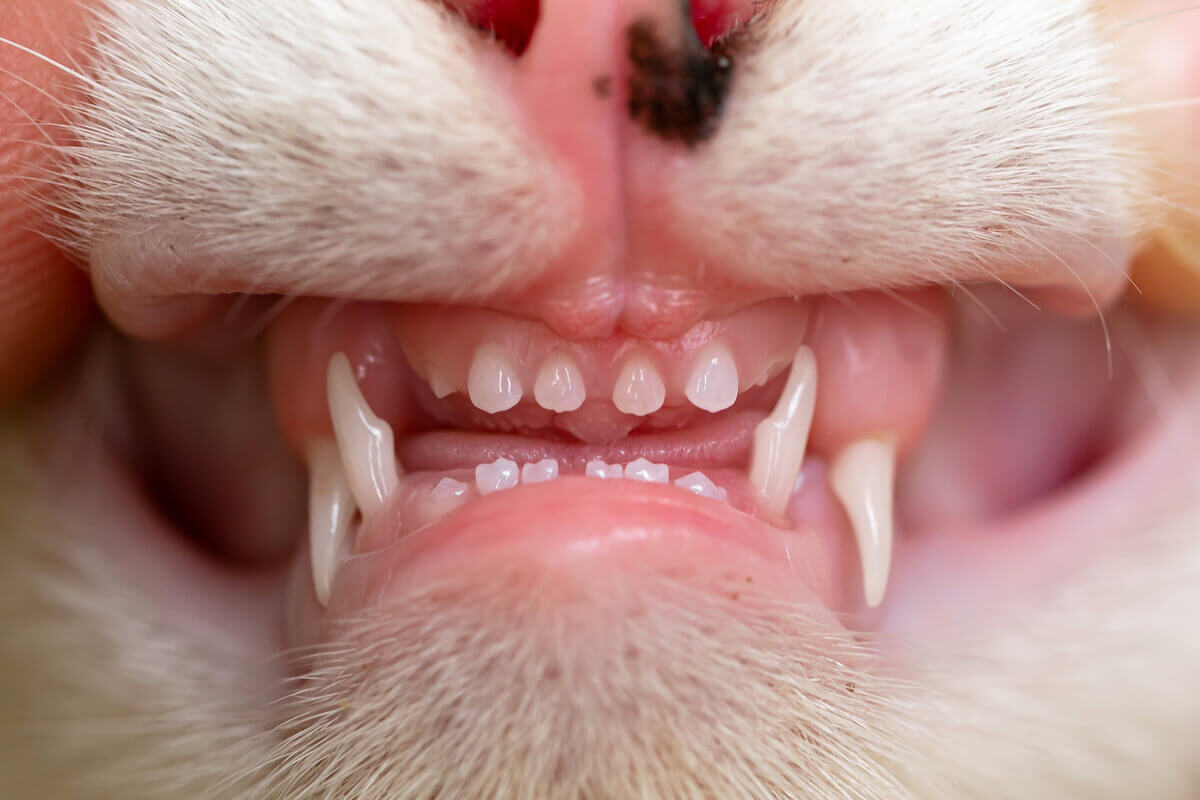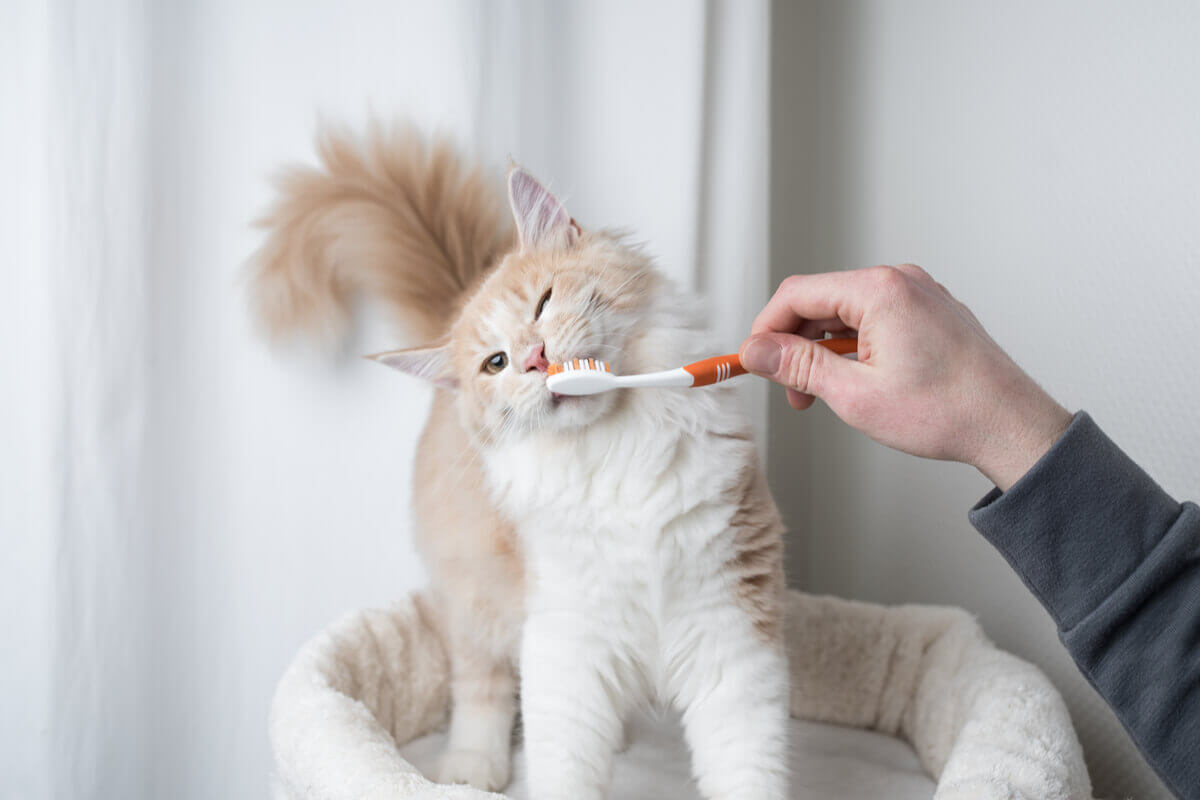When Do a Cat's Teeth Erupt?

Teeth are an excellent chewing organ for several animals because thanks to them, they’re able to pre-digest and grind their food. However, some species aren’t born with them. Rather, they grow as the individual develops. For example, a cat’s teeth erupt starting at 2 weeks after birth and the process continues until 20 weeks of age.
These dental structures are extremely important for the growth of felines, as without them, they’d be unable to ingest their food. In addition to this, the teeth also function as a defense mechanism, as they’re a sharp tool capable of causing damage to any enemy. Keep reading this article and find out when cats get their teeth.
How many teeth do cats have?
Just like humans, these felines have 2 different sets of teeth throughout their lives, which are usually called baby teeth and permanent teeth. A cat in adulthood has 30 teeth, while kittens of 3 to 4 weeks of life have a maximum of 26.
This difference is due to the normal development of cats, as they go through a process through which they manage to replace their milk teeth with permanent teeth. Although it may not seem like this change is necessary because the baby teeth only appear to allow the body to feed while it’s young. When kittens grow up, this dentition is no longer sufficient.
The baby teeth are called deciduous dentition and are made up of small and not very thick teeth. The arrangement of the 26 temporary teeth in each jaw of a kitten is as follows:
- Upper jaw: 6 incisors in front, 1 canine on each side (2), and 3 premolars on each side (6)
- Lower jaw: 6 incisors in front, 1 canine on each side (2), and 2 premolars on each side (4)
Permanent teeth are characterized by being larger than temporary teeth because the jaw of the animal grows and leaves more space for each tooth. Thanks to this, the number of teeth is 30 in total. The general arrangement of the teeth is as follows:
- Upper jaw: 6 incisors in front, 1 canine on each side (2), 3 premolars on each side (6), and 1 molar on each side (2)
- Lower jaw: 6 incisors in front, 1 canine on each side (2), 2 premolars on each side (4), and 1 molar on each side (2)

The eruption of a cat’s teeth
Tooth eruption refers to the movement of the teeth when they emerge from the gum. Although it may seem painless, the displacement of the pieces causes a series of mild discomforts in the pet, among which are the following:
- Inflammation and pain in the gums.
- Sialorrhea: Excessive salivation.
- Behavioral changes: Restlessness and slight aggression.
- Difficulty eating: Due to gum discomfort, cats often don’t eat well or eat only in small doses.
This process is very well programmed, as the order of appearance of each dental piece is tied to the age of the body. Thanks to this, we can almost completely predict the chronological plan of feline dentition and identify the approximate dates on which each tooth appears.
When do a cat’s baby teeth erupt?
Once they’re born, the teeth of the kittens begin to emerge at 3 weeks of age and the process ends at week 6. In general, the eruption of the primary teeth always begins with the incisors, followed by the canines, and ends with the premolars.
When do a cat’s permanent teeth erupt?
For permanent teeth, the replacement process begins at 11 weeks of age and ends at 24 weeks of age. During this stage, the permanent dentition begins to “push” the temporary dentition out. Eventually, this causes some symptoms of tooth eruption to reappear, as the movements irritate the feline’s mouth again.
Cat tooth care
Just like humans, cats’ teeth require some care to avoid certain diseases. It’s best to brush your cat’s mouth 3 to 7 times a week with special toothpastes and brushes for your pet. Keep in mind that toothpastes for human use contain certain harmful agents for the animal, so they can’t be used in cats.
Despite insistence, some cats don’t accept brushing their teeth and it’s not a good idea to force them to do so. In these cases, some types of food or hard treats can help with teeth cleaning because while the pet chews them, there’s an abrasive effect. However, this isn’t a complete substitute for brushing.
It’s important to note that even if you brush your cat’s teeth on a daily basis, you need to see a veterinarian for a dental check-up. Some oral ailments aren’t obvious, so only a professional will be able to identify them easily. Remember to visit the clinic at least once a year to make sure your pet doesn’t have any oral problems.
Gingivitis is very common in senior domestic felines because not all guardians clean their pet’s mouth properly.

Maintaining oral hygiene is extremely important for your pet’s health. Keep in mind that most pets have permanent dentition that must be cared for to prevent loss. Just as in humans, any neglect can seriously affect the quality of life of these wonderful companions.
All cited sources were thoroughly reviewed by our team to ensure their quality, reliability, currency, and validity. The bibliography of this article was considered reliable and of academic or scientific accuracy.
- Calderón, Z. A., Crespo, M. V., Montilla, G. Y., Paris, I., & Rojas, I. P. (2014). Odontología veterinaria: Revisión de la literatura. Rev. Venez. Invest. Odont, 2, 46-59.
- Gorrel, C. (2011). Odontologia em pequenos animais. Elsevier Brasil.
- Castejón–Gonzalez, A., de la Morena-Cabanillas, M., San Román-Llorens, F., Fernández-Sánchez, J. M., Trobo-Muñiz, I., & San Román-Ascaso, F. (2016). Odontopediatría canina y felina. Cln. Vet. Peq. Anim., 36(2), 79-89.
- Ramos Rodríguez, H. G., Nava Martínez, A., & Olivera Rodríguez, R. M. (1992). Desarrollo, erupción y características de los dientes del gato doméstico. Rev. ADM, 182-7.
- Niemiec, B., Gawor, J., Nemec, A., Clarke, D., McLeod, K., Tutt, C., … & DAVDC, D. E. (2020). Pautas dentales globales de la Asociación Mundial de Veterinarios de Pequeños Animales. Journal of Small Animal Practice, 61.
